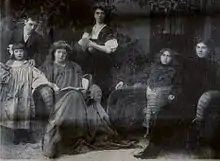Carmen Morla Lynch
Carmen Morla Lynch (1887–1983[1]), also known as Carmen Morla de Maira, was a Chilean feminist writer. The daughter of Luisa Lynch and Carlos Morla Vicuña,[2] she wrote journals illustrated by her sister Ximena,[3][4] with whom she also practiced spiritism, both as mediums. Her brother Carlos was a diplomat, writer, and journalist.[5][6] She was the great-aunt of writer Elizabeth Subercaseaux.[7]
Carmen Morla Lynch | |
|---|---|
 Morla Lynch (standing center) with her mother and siblings, 1904 | |
| Born | 1887 Paris, France |
| Died | 1983 (aged 95–96) Santiago, Chile |
| Nationality | Chilean |
| Other names | Carmen Morla de Maira |
| Spouse | Manuel A. Maira González |
| Children | Carmen |
| Parents |
|
| Relatives |
|
Work
Part of her literary output is known to be unpublished or scattered in newspapers and magazines – as is also the case with other feminist writers of the era such as her mother and sister, María Luisa Fernández, and Sara Hübner de Fresno.[3][5] Some of her unpublished work appears in the 2001 book La belle époque chilena: alta sociedad y mujeres de élite en el cambio de siglo by historian Manuel Vicuña.[8] Her literary contributions are considered to be part of the early 20th century avant-garde that sought to massify feminist thinking and fight for women's rights.[9]
For some authors, her work can be framed within so-called "aristocratic feminism", along with other writers such as Elvira Santa Cruz Ossa, Blanca Santa Cruz Ossa, Inés Echeverría Bello, María Mercedes Vial, Teresa Wilms Montt, María Luisa Fernández, and Mariana Cox Méndez.[10]
The spiritism sessions that she held with her sister Ximena in the early 20th century have inspired plays and novels.[11][12][13]
References
- Las Morla. Diarios y dibujos de Carmen y Ximena Morla [The Morlas. Journals and Drawings by Carmen and Ximena Morla] (in Spanish). Pontifical Catholic University of Chile. 2016.
- de La Goublaye, Yves; Schuler Dauvin, Santiago (2004). "Descendencia del general de la Real Armada española don Pedro Pérez de la Quintana en Chile, Perú y Bolivia (1600–2004)" [Descent of the General of the Royal Spanish Armada Don Pedro Pérez de la Quintana in Chile, Peru and Bolivia (1600–2004)]. Revista de estudios históricos (in Spanish). Chilean Institute of Genealogical Research. 45: 19–118.
- Subercaseaux, Pilar (January 1, 1999). Las Morla: huellas sobre la arena [The Morlas: Footprints on the Sand] (in Spanish). Aguilar. ISBN 9789562390743.
- Lafourcade, Enrique (1 January 1996). El Veraneo y otros Horrores [The Summer and Other Horrors] (in Spanish). LOM Ediciones. p. 25. ISBN 9789567369416. Retrieved 29 September 2017 – via Google Books.
- Subercaseaux, Bernardo (1 January 1997). Genealogía de la vanguardia en Chile [Genealogy of the Avant-Garde in Chile] (in Spanish). University of Chile Faculty of Philosophy and Humanities. p. 57.
- Valle, Ximena (2011). Mayorga, Rodrigo (ed.). Fuiste mujer, ese fue tu crimen y tu corona. Mujer y escritura en Chile entre dos épocas [You were a woman, that was your crime and your crown. Women and writing in Chile between two eras]. p. 274. ISBN 9789562848374. Retrieved 29 September 2017 – via Google Books.
{{cite book}}:|work=ignored (help) - Labarca B., Cristián (28 August 2011). "La casa de los espíritus de Providencia" [The House of the Spirits of Providence]. La Tercera (in Spanish). Archived from the original on 9 September 2014. Retrieved 29 September 2017.
- "La Belle Epoque Constituye Nuestro Presente" [La Belle Epoque Makes Up Our Present]. El Mercurio (in Spanish). 15 July 2001. Retrieved 2 October 2017.
- Subercaseaux, Bernardo (1997). Historia de Las Ideas y la Cultura en Chile, tomo III. El centenario y las vanguardias [History of Ideas and Culture in Chile, Volume III. The Centenary and the Avant-Garde] (in Spanish). Editorial Universitaria. p. 98. ISBN 9789561117075. Retrieved 28 September 2017 – via Google Books.
- Poblete Alday, Patricia; Rivera Aravena, Carla (Spring 2003). "El feminismo aristocrático: la violencia simbólica y ruptura soterrada a comienzos del siglo XX" [Aristocratic Feminism: Symbolic Violence and Buried Rupture at the Beginning of the 20th Century]. Revista de historia social y de las mentalidades (in Spanish). University of Santiago, Chile. 1 (7): 57–79. Retrieved 28 September 2017.
- Cabello, Marcello (28 February 2001). "La esoteria de las hermanas Morla" [The Esotericism of the Morla Sisters]. EMOL (in Spanish). Retrieved 29 September 2017.
- "Elizabeth Subercaseaux y la naturalidad de la muerte" [Elizabeth Subercaseaux and the Nature of Death]. El Mercurio (in Spanish). 24 October 2010. Retrieved 29 September 2017.
- Valdéz Urrutia, Cecilia (9 November 2003). "Entrevista. Juan Subercaseaux: Atmósferas mágicas" [Interview. Juan Subercaseaux: Magical Atmospheres]. El Mercurio (in Spanish). Retrieved 29 September 2017.